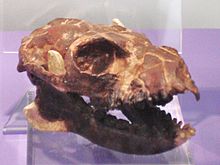- Notharctus
-
Notharctus
Temporal range: Early Eocene–Middle Eocene
Notharctus tenebrosus Scientific classification Kingdom: Animalia Phylum: Chordata Class: Mammalia Order: Primates Family: †Notharctidae Subfamily: †Notharctinae Genus: †Notharctus
Leidy, 1870Species †Notharctus pugnax
†Notharctus robustior
†Notharctus tenebrosus
†Notharctus tyrannus
†Notharctus venticolusNotharctus was an early primate that inhabited Europe and North America 50 million years ago.[citation needed] Modern lemurs evolved from primates similar to this genus.
The body form of Notharctus is similar to that of modern lemurs. Unlike lemurs, however, Notharctus had a shorter face and forward-facing eyes surrounded by an enclosed circle of bone. Its fingers were elongated for clamping onto branches, including the development of a thumb. Its spine is flexible, like the living lemurs, and the animal was about 40 centimetres (16 in) in length, excluding the long tail.[1] It probably ate fruits and insects.
The lineage that includes Notharctus, the Adapiformes, is extinct; the last representative, Sivaladapis, died out during the late Miocene.
There were at least five different Notharctus species. Fossils from at least seven other potential species have also been discovered.
References
External links
- Prehistoric prosimians
- Eocene primates
- Prehistoric mammals of Europe
- Prehistoric mammal stubs
- Primate stubs
Wikimedia Foundation. 2010.

